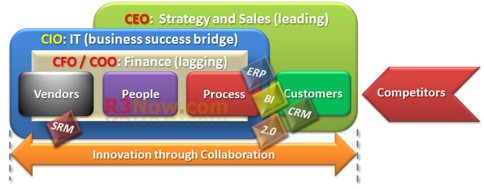
Businesses everywhere are looking to shore up their bottom lines by cutting costs. As a result, cost centers such as IT departments are prime targets for outsourcing and offshore maintenance. The typical business script is that as the IT organization moves into maintenance mode, cost centers with high overhead become a prime target for reducing costs.
However, despite how things might appear, cost is not the real driver of IT outsourcing. The real driver of IT outsourcing is function.
IT departments generally have not focused on customer acquisition, customer retention, profitability or revenue generation. Because of this, they have become commodities to be outsourced.
How Should Your SAP Support Department Differentiate Itself?
Imagine a presentation to the Board of Directors about how much money the company could save by outsourcing the sales and marketing functions. I mean, look at the massive budgets dedicated to sales and marketing!
If you were making that presentation, I would suggest you have your resume in order and already have another job lined up.
Can you imagine outsourcing discussions with that same Board of Directors if they saw IT as a strategic business partner, a business partner integrated with and indispensable to the revenue side of the business? What if the business viewed IT as a very real or even a pseudo profit center? Not only would outsourcing be off the table for IT functions directly related to revenue generation, but budget discussions and project ideas would be much easier to navigate. [FN1]
Why Has IT Become Nothing but an Expensive Cost Center?
Unfortunately, many businesses now view IT as an expensive and expendable cost center. For too long, technology departments have focused on applications, programs, and business support to address process improvement, operations, and quality. These are all the cost side of the business and only look at operational excellence. Once the bulk of the business processes are set up, running, and stable, any significant IT labor costs are subject to being cut. From there, many businesses decide to outsource, reduce staff, or off shore.
Is operational excellence important? Of course it is. However, after integrating and automating the back-office functions or operations of the business, IT must then move on to product or service innovation along with revenue.
Unless they begin looking at the key revenue generation functions of the business, IT will forever remain an expendable cost center rather than a key business partner.
Why Won’t CRM Applications Work to Change the IT to Business Dynamic?
A few of the applications in the market have tools and resources to structure the customer acquisition and customer retention processes. Some of these applications have decent rules-based tools for automatically evaluating and then stratifying customers. Additionally, a number of major and several niche applications have a functionality for handing special offers, marketing programs, or other incentives focused on customer retention or increasing sales conversions.
Why Isn’t CRM Delivering?
CRM isn’t delivering for three primary reasons: 1) clueless “CONsultants” may have some exposure to a CRM application but little or no business knowledge [FN2]; 2) few applications, if any at all, integrate and then actively engage customers in the business they are buying from [FN3]; 3) sales and marketing programs are poorly structured and do not allow for good sales process analysis. [FN4]
In the SAP CRM space, the frauds and fakes in the marketplace keep you from achieving full benefit. They entered the market when the applications were immature and experience requirements were low. They came in droves with fake resumes, fake credentials, and little or no knowledge in sales and marketing. [FN4]
Nearly all CRM applications are focused on sales processes, measuring conversion or retention, and all of the other sales process areas. Software and IT applications do not directly engage the customer in the new product or service development cycle, quality management, marketing, feature or benefit development, or product or service frustrations. Archaic customer service centers serve as a touch point to the customer, but beyond that, customers are not intimately involved in, or incorporated into, the business product or service lifecycle.
Conclusion on IT as a Cost Center and IT Outsourcing
Until IT aggressively focuses on the business side of the equation (revenue, profitability, customer retention, customer acquisition, product development and engineering, etc.), IT is little more than a dispensable cost center.
This model shows the IT application landscape of the future. It also shows the CIO role as a bridge between the CFO and the CEO, or between lagging and leading indicators of business performance and success.
Source: Future Technology Landscape Alignment for the CIO, IT Director, or Key IT Decision Maker
Once again I will reiterate one of my opening paragraphs here;
Can you imagine outsourcing discussions with that same Board of Directors if they saw IT as a strategic business partner, a business partner integrated with and indispensable to the revenue side of the business? What the business viewed IT as a very real or even a pseudo profit center? Not only would outsourcing be off the table for IT functions directly related to revenue generation, but budget discussions and project ideas would be much easier to navigate.
This model shows IT in precisely this way. Application alignment is focused on the customer.
Footnotes and Resources about IT Strategic Alignment with Business – Customer Retention, Customer Acquisition, and Revenue Generation
[FN1] See these additional resources about business to IT to customer alignment:
Changing the Direction of SAP, ERP, and IT Applications to Focus on the Customer and Innovation
CIO, CFO, and CEO Alignment – Why ROI is Lacking from Today’s System Landscape
[FN2] Many businesses and Corporate IT departments have been sold a “bill of goods” with little to show for their investment
CRM, ERP, BI, and IT Investment — Where Do You Find the Business Benefit?
[FN3] See the customer integration model for the IT landscape of the future which integrates the customer into the business process.
Business and IT Alignment – Integrating Technology and IT Spend with Business
[FN4] There is a fundamental change needed in how performance is perceived and measured to understand how to make a difference.






